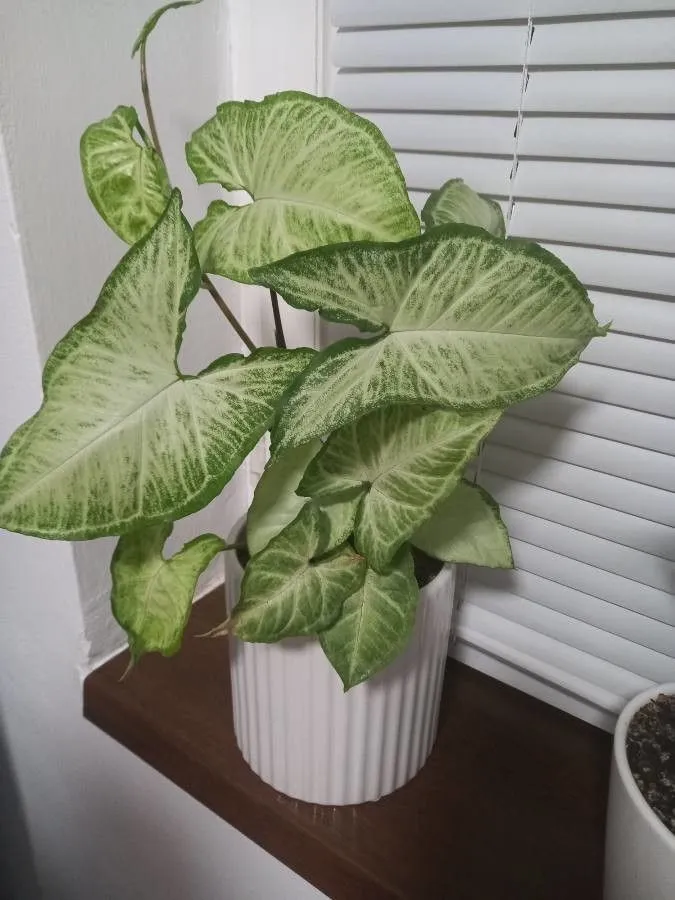
Author: Schott
Bibliography: Bot. Zeitung (Berlin) 9: 85 (1851)
Year: 1851
Status: accepted
Rank: species
Genus: Syngonium
Vegetable: False
Observations: Mexico to Trop. America
African Evergreen (Syngonium podophyllum)
The African Evergreen, scientifically known as Syngonium podophyllum, is a member of the Araceae family and was first detailed by Schott in 1851, as noted in Bot. Zeitung (Berlin) 9: 85. This versatile and appealing plant has roots that trace back to various regions, spanning from the fertile lands of Mexico to the diverse climates of Tropical America.
Syngonium podophyllum is celebrated for its lush, arrowhead-shaped leaves that exhibit a diverse palette of green hues, sometimes accented with streaks or patches of white or silver, adding both texture and visual interest to any indoor or outdoor setting. Initially, the leaves are typically a simple arrowhead shape, but as the plant matures, the leaves can transform into a segmented, lobed format, showcasing the unique evolutionary adaptability of this species.
In its native habitat, the African Evergreen thrives under the canopy of tropical forests, where it receives dappled sunlight filtered through the dense foliage above. Its natural inclination for climbing allows the plant to seek light by ascending trees or spreading across the forest floor, making use of its aerial roots. When cultivated indoors, it performs best in similar conditions — indirect light, high humidity, and a well-draining potting mix that retains some moisture without becoming waterlogged.
The ease of care is another notable characteristic that makes Syngonium podophyllum a popular choice among plant enthusiasts. It adapts well to varying light conditions, though it will exhibit slower growth and less vibrant foliage in lower light settings. Regular watering, ensuring the soil is consistently moist but not overly saturated, combined with occasional feeding during the growing season (spring through summer) supports its overall health and robust growth.
As it matures, the African Evergreen can grow quite vigorously, warranting periodic pruning to maintain its desired shape and size. This also encourages bushier growth, preventing the plant from becoming too leggy. Propagation is relatively straightforward, often achieved through stem cuttings that root easily in water or soil, allowing plant lovers to share their botanical treasure with others or expand their collection.
In addition to its aesthetic appeal, Syngonium podophyllum also contributes to indoor air quality, as it’s known to effectively filter common household toxins from the air, promoting a healthier living environment. However, it’s important to note that all parts of the plant contain calcium oxalate crystals, which can be toxic if ingested, making it essential to keep the plant out of reach of pets and young children.
Whether gracing a tabletop in a compact pot, cascading from a hanging basket, or climbing a support structure to bring a touch of the tropics into your home, the African Evergreen remains a timeless favorite among plant enthusiasts. Its resilience, coupled with its striking foliage, ensures it continues to be a cherished and enduring addition to indoor plant collections around the world.
Eng: african evergreen, american evergreen, arrowhead vine, arrowhead-vine, nephthytis
Swe: pilspetsranka
Deu: veränderliche purpurtüte
En: African evergreen, American evergreen, Arrowhead-vine, Nephthytis, Arrowhead vine, Goosefoot, 合果芋
Zh: 合果芋
Fi: Muulinkultakorva
De: Veränderliche Purpurtüte
Kn: ಸಿಂಗೋನಿಯಮ್ ಪೊಡೊಫಿಲಮ್
Ms: Tapak angsa
Fa: سینگونیوم پودوفیلوم
Pl: Zroślicha stopowcowa
Es: Garrobo.
Sv: Pilspetsranka
Zh-tw: 合果芋
Th: เงินไหลมา
Zh-hant: 合果芋
Taken Sep 26, 2019 by Cabrera José (cc-by-sa)
Taken Dec 18, 2020 by avy calanog (cc-by-sa)
Taken Sep 4, 2019 by Galina_Ars Galina_Ars (cc-by-sa)
Taken Dec 23, 2020 by Anela Radisic (cc-by-sa)
Taken Jul 30, 2019 by Dekhili oualid (cc-by-sa)
Taken Oct 24, 2021 by L Brown (cc-by-sa)
Taken Jan 1, 1900 by EOL − Bart Wursten (cc-by-nc)
Taken May 17, 2019 by Marzanna Bug (cc-by-sa)
Taken Jan 1, 1900 by EOL − AlejandroLinaresGarcia (cc-by-sa)
Taken Feb 4, 2022 by Oliveira Vander (cc-by-sa)
Taken Aug 6, 2017 by Felippe Felippe (cc-by-sa)
Taken Jan 1, 1900 by EOL − Forest & Kim Starr (cc-by)
Taken Apr 14, 2020 by Ana Molina (cc-by-sa)
Taken Jan 25, 2021 by ina rb (cc-by-sa)
Taken Oct 15, 2021 by Gabriel Purcaru (cc-by-sa)
Taken Jan 1, 1900 by EOL − Meneerke bloem (cc-by-sa)
Taken Jan 1, 1900 by EOL − Acevedo, P. (cc-by-nc-sa)
Taken Jan 1, 1900 by EOL − Encyclopedia of Life (cc-by-sa)
Taken Jan 1, 1900 by EOL − Acevedo, P. (cc-by-nc-sa)
Taken Dec 5, 2021 by Elena Tkacheva (cc-by-sa)
Taken Nov 6, 2020 by Lisa Ani (cc-by-sa)
Taken Oct 12, 2021 by Maximus Prime (cc-by-sa)
Taken Oct 20, 2020 by barbiero filho ivan (cc-by-sa)
Taken Oct 26, 2020 by Silva Gerson Roberto da (cc-by-sa)
Taken Apr 10, 2019 by D. Taylor (cc-by-sa)
Taken Apr 26, 2021 by Asim Kumar Mishra (cc-by-sa)
Taken Nov 21, 2022 by Prasanta Hembram (cc-by-sa)
Taken Mar 15, 2021 by Megyeri Timea (cc-by-sa)
Taken Jul 9, 2021 by kora leach (cc-by-sa)
Taken Aug 9, 2022 by Mufasa193 (cc-by-sa)
© copyright of the Board of Trustees of the Royal Botanic Gardens, Kew.
© copyright of the Board of Trustees of the Royal Botanic Gardens, Kew.
© copyright of the Board of Trustees of the Royal Botanic Gardens, Kew.
Growth habit>: Vine
Family: Myrtaceae Author: (F.Muell.) K.D.Hill & L.A.S.Johnson Bibliography: Telopea 6: 402 (1995) Year: 1995 Status:…
Family: Rubiaceae Author: Pierre ex A.Froehner Bibliography: Notizbl. Bot. Gart. Berlin-Dahlem 1: 237 (1897) Year:…
Family: Sapindaceae Author: Koidz. Bibliography: J. Coll. Sci. Imp. Univ. Tokyo 32(1): 38 (1911) Year:…
Family: Asteraceae Author: A.Gray Bibliography: Pacif. Railr. Rep.: 107 (1857) Year: 1857 Status: accepted Rank:…
Family: Fabaceae Author: Medik. Bibliography: Vorles. Churpfälz. Phys.-Ökon. Ges. 2: 398 (1787) Year: 1787 Status:…
Family: Aspleniaceae Author: (Cav.) Alston Bibliography: Bull. Misc. Inform. Kew 1932: 309 (1932) Year: 1932…